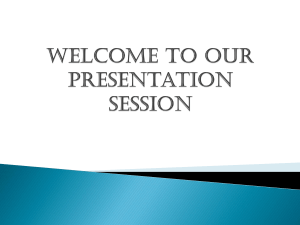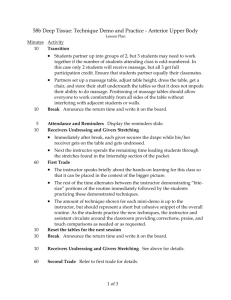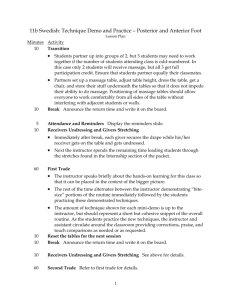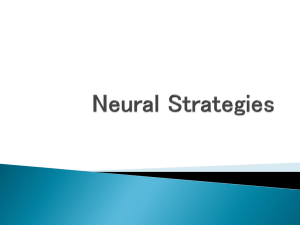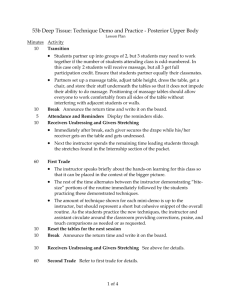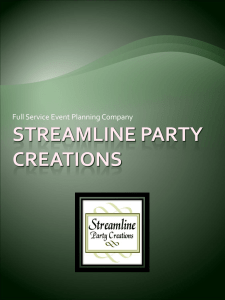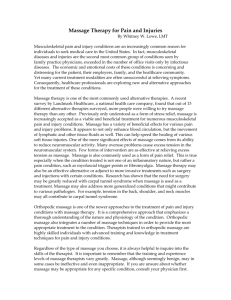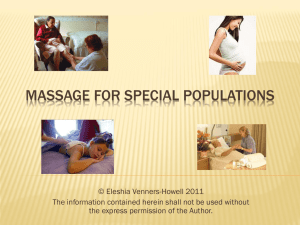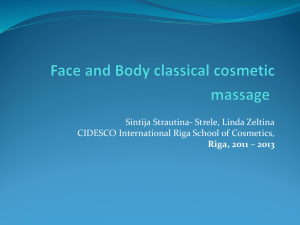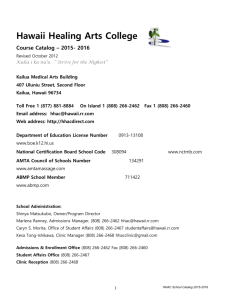UNIVERSITY OF KENT
advertisement
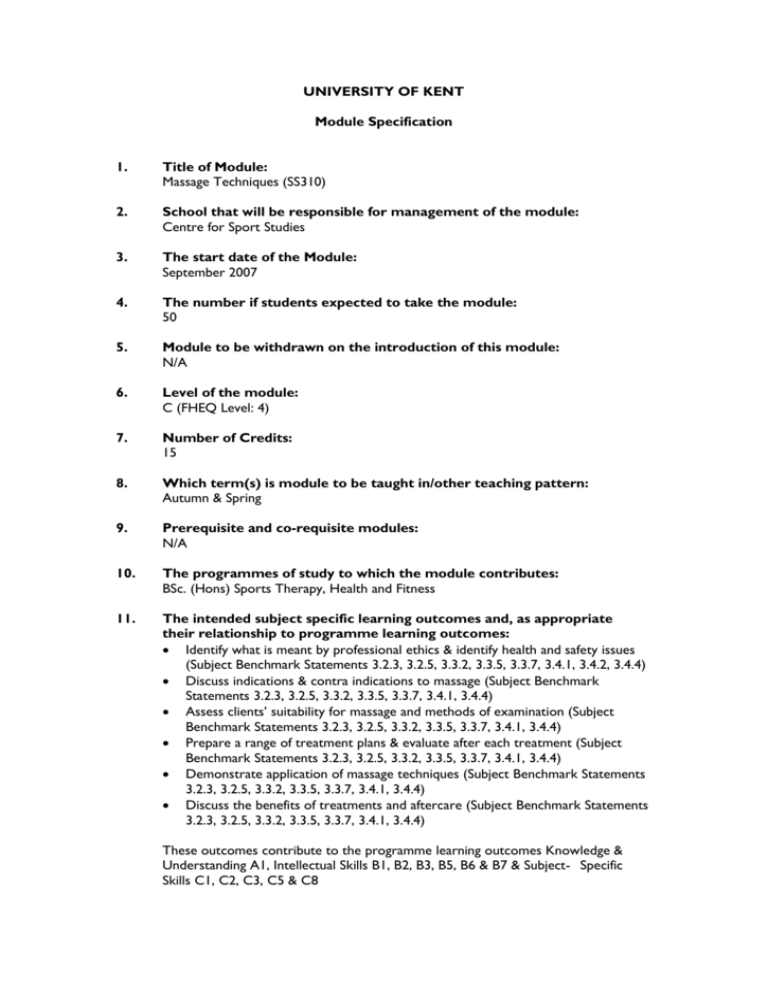
UNIVERSITY OF KENT Module Specification 1. Title of Module: Massage Techniques (SS310) 2. School that will be responsible for management of the module: Centre for Sport Studies 3. The start date of the Module: September 2007 4. The number if students expected to take the module: 50 5. Module to be withdrawn on the introduction of this module: N/A 6. Level of the module: C (FHEQ Level: 4) 7. Number of Credits: 15 8. Which term(s) is module to be taught in/other teaching pattern: Autumn & Spring 9. Prerequisite and co-requisite modules: N/A 10. The programmes of study to which the module contributes: BSc. (Hons) Sports Therapy, Health and Fitness 11. The intended subject specific learning outcomes and, as appropriate their relationship to programme learning outcomes: Identify what is meant by professional ethics & identify health and safety issues (Subject Benchmark Statements 3.2.3, 3.2.5, 3.3.2, 3.3.5, 3.3.7, 3.4.1, 3.4.2, 3.4.4) Discuss indications & contra indications to massage (Subject Benchmark Statements 3.2.3, 3.2.5, 3.3.2, 3.3.5, 3.3.7, 3.4.1, 3.4.4) Assess clients’ suitability for massage and methods of examination (Subject Benchmark Statements 3.2.3, 3.2.5, 3.3.2, 3.3.5, 3.3.7, 3.4.1, 3.4.4) Prepare a range of treatment plans & evaluate after each treatment (Subject Benchmark Statements 3.2.3, 3.2.5, 3.3.2, 3.3.5, 3.3.7, 3.4.1, 3.4.4) Demonstrate application of massage techniques (Subject Benchmark Statements 3.2.3, 3.2.5, 3.3.2, 3.3.5, 3.3.7, 3.4.1, 3.4.4) Discuss the benefits of treatments and aftercare (Subject Benchmark Statements 3.2.3, 3.2.5, 3.3.2, 3.3.5, 3.3.7, 3.4.1, 3.4.4) These outcomes contribute to the programme learning outcomes Knowledge & Understanding A1, Intellectual Skills B1, B2, B3, B5, B6 & B7 & Subject- Specific Skills C1, C2, C3, C5 & C8 12. The intended generic learning outcomes and, as appropriate, their relationship to programme learning outcomes: Demonstrate an ability to integrate the “key skills”. Communication and presentation skills - via the use of student lead demonstrations on a variety of subject specific material with both individual and group settings used. Also through the use of client consultation skills and patient handling SB 3.51 Numeracy & Information Technology - will be used for the preparation of the client portfolio SB 3.52 Interactive group skills – evidenced through conducting student lead tasks SB 3.53 Problem solving – will be enhanced through the need to identify and diagnose sporting injuries and complications SB 3.54 Ability to self-appraise and reflect on practice – evidenced within client portfolio and oral assessments SB 3.55 Ability to plan and manage learning - through completing the extra self directed study necessary to complete the client portfolio SB 3.56 These outcomes contribute to the programme learning outcomes and Transferable Skills D1, D3, D5, D6, D8, D9, D10 & D11. 13. A synopsis of the curriculum: Types of massage strokes used Indications and contra-indications massage Massage of the Back, Shoulders and Gluteals, Posterior and Anterior Leg and Arm, Neck Professional Ethics and Code of Practice Health, safety and security legislation Pre- and post event massage techniques Client consultations – Medical History, SOAP notes Client examinations – Spine, Pelvis and Hip, Knee, Ankle and Foot, Shoulder, Elbow, wrist and hand Muscle energy techniques Soft Tissue Release 14. Indicative Reading List: Archer, P. (2007) Therapeutic Massage in Athletics. Baltimore:LWW Biel, A. (2005) Trail Guide to the Body. Boulder: Books of Discovery Cash, M. (1996) Sports & Remedial Massage Therapy. London: Ebury Press Cassar, M. (2004) Handbook of Clinical Massage. Churchill Livin Clay, J. Pounds, D. (2003) Basic Clinical Massage Therapy. Baltimore:LWW Fritz, S (2005) Sports and Exercise Massage. Mosby Hendrickson,T. (2003) Massage for Orthopedic Conditions. Baltimore:LWW Lowe, W. (2003) Orthopedic Massage. London:Mosby Scheumann,D. (2007) The Balanced Body: A guide to deep tissue and neuromuscular Therapy. Baltimore: LWW Riggs, A. (2002) Deep Tissue Massage: A visual guide of techniques. Berkely,CA: North Atlantic Books 15. Learning and Teaching Methods, including the nature and number of contact hours and the total study hours which will be expected of students, and how these relate to achievement of the intended learning outcomes Total hours for the module will be 150. This will consist of one 2 hour Lecture per week. These contact hours will total 40 in which the intended learning outcomes will be covered. The remainder will be devoted to private study & construction of a 70 hour Client Portfolio for the reinforcement of knowledge and private study. The Lecture will introduce each topic area and explain the key issues in the subject. Lectures will cover Intended Learning Outcomes a, b, c, d, e & f. These will be covered using a variety of oral and visual lecture materials. PowerPoint slides will be made available to students on WebCT, readings and other material will also be placed on WebCT. Lectures will include a practical application of ILO c,d,e,f The practical application will cover Intended Learning Outcomes a,b,c,d,e,f and Generic Learning Outcomes: Communication and presentation skills, interactive group skills and problem solving Private study is expected of the students, this will help develop and reinforce their knowledge and understanding of the topics and material covered in lectures. It will also allow them to develop Generic Learning Outcomes critical thinking skills, numeracy & information technology, problem solving, ability to self-appraise and reflect on practice, and the ability to plan and manage learning. 16. Assessment methods and how these relate to testing achievement of the intended learning outcomes 50% Observed client consultation and massage (ILO b, c, e & f & GLOa). 50% Client portfolio (ILO a, c, d, e & f & GLOa). 17. Implications for learning resources, including staff, library, IT and space The module will be convened by an existing member of the Centre for Sports Studies. Library and IT resources will be provided by utilising existing provision with the view to further expansion as required. It is expected that physical teaching space will be available including the usage of a treatment clinic. There will also need to be sufficient numbers of Massage couches to allow one per two students. 18. Students with disabilities The majority of disabilities will be catered for. However it will be up to the discretion of the module convenor whether to accept a student with a disability on to the module. The main criteria will be if the disability will cause discomfort or danger to either themselves or their potential clients. Statement by the Director of Learning and Teaching: "I confirm I have been consulted on the above module proposal and have given advice on the correct procedures and required content of module proposals" ................................................................ .............................................. Director of Learning and Teaching Date Statement by the Head of School: "I confirm that the School has approved the introduction of the module and will be responsible for its resourcing" ................................................................. Head of School .............................................. Date


